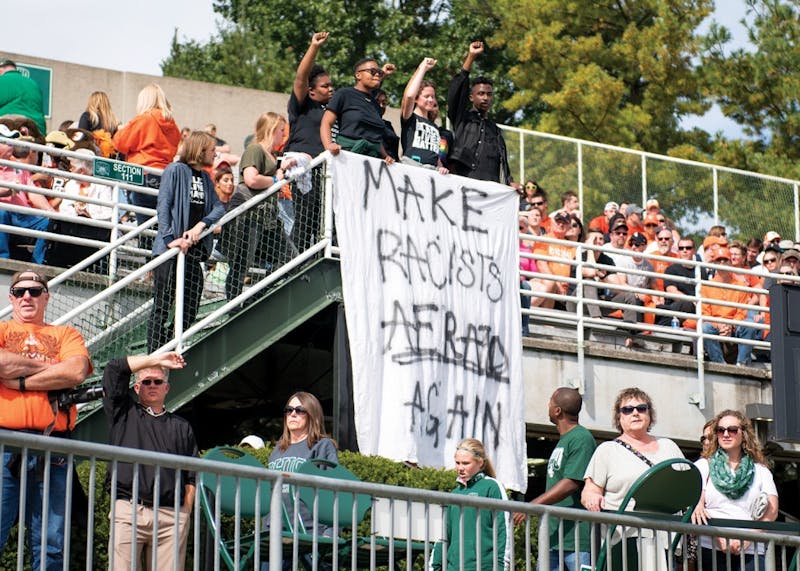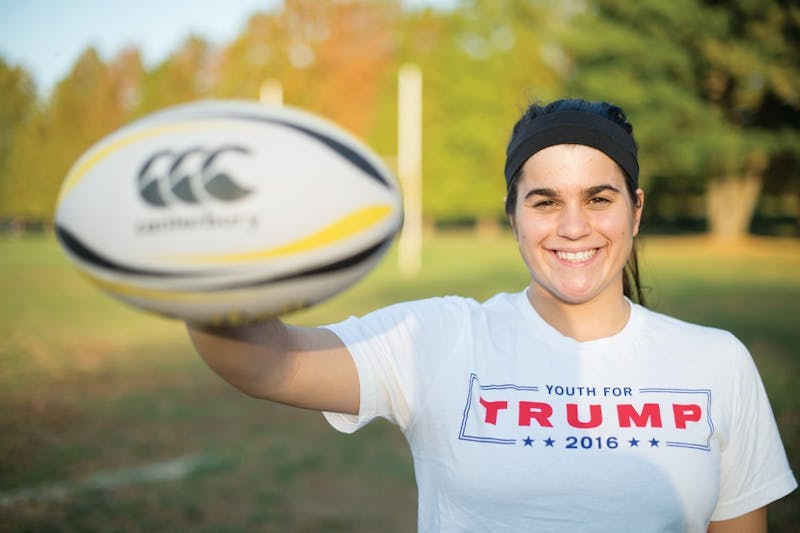


BLAKE NISSEN
The sun was hot for an October Saturday in Athens, but that did not stop what was likely one of the biggest crowds of the year from forming at Peden Stadium.
It was Homecoming Weekend and a boisterous crowd gathered to watch Ohio play visiting Bowling Green. That crowd, however, saw something not-so-typical.

CARL FONTICELLA
Members of EPIC (Enforce, Protect, Include, and Create) hold up a banner that reads "Make Racists Afraid Again" at the Homecoming football game on Saturday, October 8, 2016.
While the game was being played on the field, a group of roughly eight demonstrators unveiled a large banner with the declaration “Make Racists Afraid Again” and led a chant of “Black Lives Matter.” They remained standing while a group behind them began an attempt to drown them out with an “All Lives Matter” chant of their own, and before long, the demonstrators and their banner were quietly escorted from the stadium.
“It was a little uncomfortable,” Maddie Platfoot, a sophomore studying education, said. “(The game) was such a fun atmosphere, and then you have this statement that puts you in a spot where you don’t really know how to feel.”
The event reflected how social and political issues creep more into sports every day.
San Francisco 49ers quarterback Colin Kaepernick began to kneel during the national anthem in protest of police shootings, presidential candidates he deemed unfit and rampant oppressive racism that violated people’s rights. The protest, which has stretched to many sports all the way down to the high school level, is not the only place sports and politics intersect.
Demonstrations similar to the one during Ohio’s Homecoming game happen in many places, and the lines between sports and politics continue to approach one another — and college athletes can often find themselves caught in the middle.
Athletes have influential voices, even in college. For Anthony Reynolds, Ohio’s assistant athletic director for media relations, that should be encouraged, not hidden away.
“We don’t turn (the athletes) away from anything,” Reynolds said. “The biggest thing is to keep the ball in their court. It’s never about trying to limit them as human beings or limit their freedom of speech. That’s not what our athletic department is about.”
A lack of formal guidelines in Ohio’s athletic department gave coaches the freedom to implement their own rules for their players. Those philosophies often boil down to a simple rule of knowing how words and actions reflect back upon the team and the university as a whole.
“Be careful what you say and how you say things,” former Ohio linebacker Jovon Johnson, a 2016 alumnus, said. “When you say things, and you’re not on video, the tone of some things you say can be taken out of context. So just be truthful in what you say ... and how you say it.”
That is a line each athlete must figure out how to walk on his or her own. The athletics department does not govern social media or place restrictions on what players are able to post, or with whom they are able to interact.
What athletes post to their private social media pages is up to them, as is their right to publicly protest a social issue such as racial injustice — something Ohio Athletics has yet to see any example of in 2016.

JON WARD
Head football coach Frank Solich, who has nearly 50 years of coaching experience under his belt following a collegiate football career of his own, said he recently spoke with his team in depth about what he would like to see from them in terms of social awareness.
“We are open to what our players’ thoughts and feelings are,” Solich said. “We have had several discussions this past week. I think our players are in the know in terms of the fact that no one here in this program would hold anything against them for awareness. Awareness is good.”
While Ohio does not restrict its players in what they can say or post publicly, the same philosophy is not universal with other teams and schools. Some teams have policies in which they force their players to make their social media accounts private or impose other restrictions on them. That can only go so far, as Northwestern’s football coaching staff recently learned, when the National Labor Relations Board ruled the team’s policy of banning players from social media altogether to be unlawful, forcing the team to lift the ban.
That is perhaps the best example of the double-edged sword that teams can run into. Once schools begin to impose regulations on athletes they wouldn’t impose on other students, they begin to inch closer to an athlete being considered an employee, which goes against the fundamental stance the NCAA has had on athletes for decades.
“If you’re a college athlete, you don’t check your rights at the door,” B. David Ridpath, an associate professor of sports administration, said. “You’re not a private employee; you’re supposed to be a student. So you have every right, whether people like it or not, to participate in the social process. … Anyone who tries to discourage that is flat out wrong.”

MATT STARKEY
Women's rugby player Serena Valente poses for a portrait while wearing a Trump shirt on October 18, 2016.
If an athlete comes forward with a stance others outside their team disagree with, it may not take much for the athlete to push those outside voices aside. When teammates or coaches have conflicting viewpoints on controversial subjects, though, that becomes tougher to work through.
That was made clear in a recent Bleacher Report examination that explored of how divided NFL locker rooms are becoming in light of the presidential election. But for athletes at Ohio University, having dissenting opinions on political matters doesn’t always have to be a death sentence for relationships between teammates.
“Because we’re all friends, we all have our debates and friendly arguments,” Serena Valente, a club rugby player and member of the OU College Republicans, said. “We’ve actually watched one of the debates together, and we have a group chat where, during the debates, we’ll comment and stuff. We all get along. It’s never anything with tension.”
Because of the different backgrounds and points of view available in a team setting, a locker room or team bus could be a rewarding place to hold difficult conversations about complex political and social issues. They can also, however, provide an opportunity for conflict that may not have otherwise arisen.
Head hockey coach Sean Hogan said going on the road for the first time is typically when the team finds out whether those conversations are going to be problematic or if they’re going to come up at all.
“The most important thing is that you have to know when to have the conversations and when not to have them,” Alex Vazquez, a senior defenseman on the hockey team, said. “That’s the number one rule. There’s time to talk about that stuff and times you shouldn’t. Some guys don’t have that rule, but for me, it’s my No. 1. You gotta know what you’re allowed to talk about, with who and where.”
Protests aren’t new, and the fact challenging topics are always going to be debated between teammates isn’t either. Long after the election is held in November, athletes will be tasked with undefined roles in the social and political landscape, and each will have navigate it on his or her own.